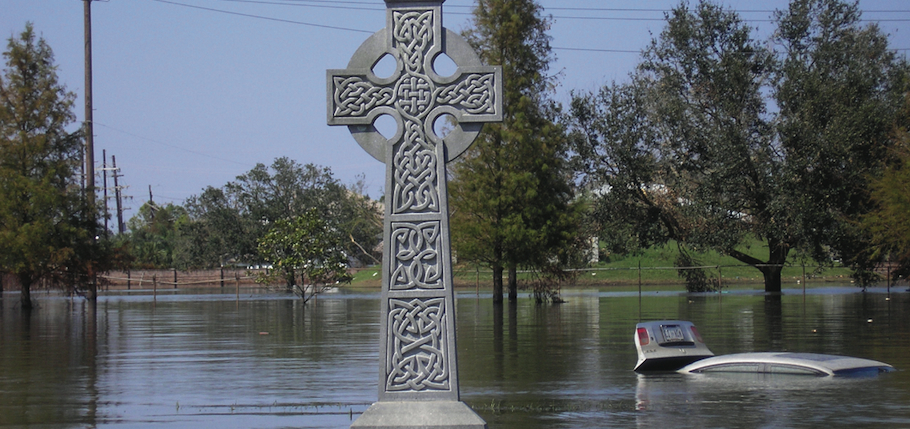A mong the many victims when a major city experiences near death are the personal artifacts of the families who called it home and the history of the people and ancestors who came before them.
That’s how it stands today in New Orleans. Lost in the ineffectual largesse of governmental bureaucracy and the dreadful minutiae of insurance contracts are quite literally thousands of monuments which before the storm were carefully and lovingly maintained by heritage societies.
A mere stone’s throw from one of the major levee failures in the Lakeview neighborhood rests a monument erected by the Irish Cultural Society of New Orleans. Dedicated on November 4, 1990, it was built to honor the estimated 8,000 to 20,000 Irish immigrants who died during the construction of the New Basin Canal beginning in 1832.
Carolyn Scanlon, the wife of the deceased Henry Scanlon, one of the past presidents of the Society, explains that they erected the monument to honor the thousands of Irishmen who died of Yellow Fever and the harsh work conditions over the course of the six years of its construction. At the time, Irish labor was considerably less expensive than slave labor, and with the constant influx of these immigrants coming through the port, they had a never-ending source of bodies. She states, “These men who were working for an incredibly low wage and maybe a shot of whiskey, would die and then were simply and unceremoniously buried in the levees along the banks of the canal they were building.”
According to Margaret Ramsone, the Program Coordinator for the Society, the original planning for the monument took two years. They raised over $20,000 through local fundraisers to erect a large Irish Cross, built from Kilkenny Marble, in the center of the monument. “We were honored to have the Irish Ambassador to the United States on hand for the dedication in 1990,” she said.
The canal eventually lost its economic viability as a waterway between downtown New Orleans and Lake Pontchartrain and was completely filled in by 1950, with much of it converted to a large park, where the monument now sits. After Hurricane Katrina, and the over nine feet of floodwaters were finally pumped out from the surrounding neighborhood, the New Basin Canal Park became a monstrous holding area for flood debris.
Day in and day out, hundreds of trucks would pour onto the park grounds and deposit their loads of personal belongings, televisions, appliances, plaster walls and heart of pine wood floors only to be ground together into unrecognizable heaps of waste. The U.S. Army Corps of Engineers also took over a large tract of the park for holding and drying the bottom soil from the dredging and construction of the new floodgates at the nearby 17th Street Canal.
“By some miracle someone actually went out and roped off the monument site,” states Kevin Gilheany, the current President of the Irish Cultural Society. “It’s now completely surrounded by hills of canal mud and completely overgrown. But with so many of our members flooded out and still scattered to the four winds, unable to return to their homes even today, we’ve lost a lot of the people that we would call on to help maintain the monument. Many of the ones who have returned are living in their FEMA trailers and are getting up there in age.”
The Irish Cultural Society of New Orleans was founded almost 30 years ago; the exact date is difficult to track down, since the group’s historical documents were lost in the flood. The Society was originally formed to promote Irish heritage events in New Orleans through an affiliation with the Irish American Cultural Institute. Gilheany describes how the group was “funneling Irish musicians, poets and professors through the city. We were constantly putting on Irish plays and dances.”
Another big loss for the city was O’Flaherty’s Pub in the French Quarter, which became a headquarters of sorts for these displays of Irish culture. Although the pub did not experience any flooding, the dearth of tourists coming through New Orleans brought about its demise.
Today, many of the city’s historic Irish pubs have reopened and on St. Patrick’s Day this year, the traditional parading went on through the Irish Channel neighborhood. But much more still has yet to restored and revitalized. On November 5, the 16th anniversary of the monument’s dedication, Carolyn Scanlon and Margaret Ramsone laid a wreath at the base of the cross.


I ran across this looking for an old Seabee friend Henry Scanlon a fine gentleman and true Irish. I wondered if he was the same one